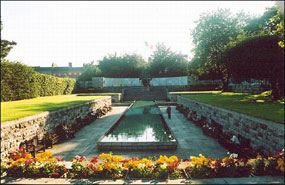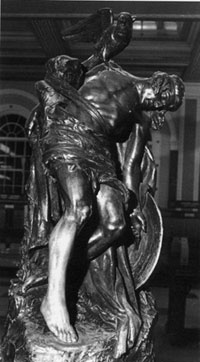| |

Traditions, folklore, history and more. If it's Irish, it's here. Or will be!
"People will not look forward to posterity who never look backward to their ancestors."
-Edmund Burke




Quotes
Library: Books, Movies, Music
Prints & Photos
Poetry
Jokes


Shops Ireland
Bunús na Gaeilge
(Basic Irish)
Circle of Prayer
Blessings
Did You Know?
Himself/Herself
Write to Us
Readers Write..
Links/Link to Us
Advertise with us
Awards & Testimonials
Submissions Guide


|
|
|
Landmarks commemorating The 1916 Rising
by Bridget Haggerty
 The Garden of Remembrance The Garden of Remembrance
At the northern end of Parnell Square in Dublin is a small, peaceful park, dedicated to the men and women who have died in pursuit of Irish freedom.
The Garden of Remembrance marks the spot where several leaders of the 1916 Easter Rising were held overnight before being taken to Kilmainham Gaol, and where the Irish Volunteers movement was formed in 1913.
The park also commemorates those who died in other conflicts in the struggle for Irish freedom, notably:
• the 1798 rebellion
• the 1803 rebellion
• the Young Ireland rebellion
• the Fenian uprising in the 1860s
• the land wars, and
• the Irish War of Independence between 1919 and 1922.
 The Garden was opened in 1966 by President de Valera on the fiftieth anniversary of the Easter Rising. The Dublin architect and conservationist Daithi Hanly RIP designed the lawns, which encircle a sunken pool. The floor of the pool displays a mosaic pattern of blue green waves interspersed with ancient weaponry. The spears are shown broken following the ancient Celtic custom of throwing weapons into rivers and lakes as offerings to the gods when hostilities ended. The Garden was opened in 1966 by President de Valera on the fiftieth anniversary of the Easter Rising. The Dublin architect and conservationist Daithi Hanly RIP designed the lawns, which encircle a sunken pool. The floor of the pool displays a mosaic pattern of blue green waves interspersed with ancient weaponry. The spears are shown broken following the ancient Celtic custom of throwing weapons into rivers and lakes as offerings to the gods when hostilities ended.

At one end of the park stands a bronze statue of the Children of Lir, sculpted by Oisin Kelly RIP. The children are an important part of Irish folklore - they were turned into swans by their jealous stepmother for 900 years. They became human again after this time but, frail and weak, died soon afterwards. Today, killing a swan in Ireland is illegal, and while it might be sentimental to think that it’s because of the Lir legend, it’s most likely a law that was introduced relatively recently.
The sculpture evokes Yeats' famous lines about the 1916 Rebellion: "All is changed, changed utterly: A terrible beauty is born".
The plaque reads:
"In the darkness of despair we saw a vision. We lit the light of hope and it was not extinguished. In the desert of discouragement we saw a vision. We planted the tree of valour and it blossomed.
In the winter of bondage we saw a vision. We melted the snow of lethargy and the river of resurrection flowed from it.
We sent our vision aswim like a swan on the river. The vision became a reality. Winter became summer. Bondage became freedom and this we left to you as our inheritance.
O generations of freedom remember us. The generations of the vision."
 The Death of Cuchalain The Death of Cuchalain
This dramatic sculpture by Oliver Sheppard was unveiled on Easter Sunday, April 21, in 1935 and was chosen by De Valera as the national memorial to participants of the 1916 Rising.
According to Seamus Cashman, “For decades this was a genuinely public work of art, to be touched and admired close up and away from any side. Like much in this renovated Republic, it can no longer be enjoyed (and the An Post postcard image is reversed!). It is now alcoved, rendered cold and untouchable, behind reflecting glass streetside, rear-end to the viewer inside. It is cast in bronze and would survive millennia of caresses. Give it back to us and to our children. This artwork belongs to the citizen.”
These words are from a pamphlet published in February 2006 when the Irish government was in the midst of planning to re-introduce a military parade in observance of the 90th anniversary of the Rising.
Entitled “Step Together - From Pillar to Spire”, it is a proposal for a celebration of Citizenship of the Irish Republic by marching together on Citizens Day.
Once again, a quote from the pamphlet: “Citizenship of the Irish Republic has an integrity we tamper with at our peril. More than any other quality of the Republic as founded and developed since, it is the integrity of our citizenship that we ought to celebrate. That integrity, that citizenship, cannot be honoured by military parades. Today, such a display of physical-force power, established for defence and security denigrates the need for armed rebellion, perceived by the rebels of 1916 (and many other conflicts). They lived in a monarchical, militarised colony; we live in a democratic republic. They were 'subjects.’ we are citizens.”
Mr. Cashman’s proposal is a compelling read which includes a plethora of quotes from the likes of Thomas Paine, Wolf Tone, James Connolly and many others. The booklet also contains all of the words to the Proclamation read by patrick Pearse at 12:45 pm on April 24, Easter Monday, on the steps of the General Post Office on Sackville Street, now O’Connell Street.
Have you read it?
So, instead of being a spectator and watching a sham show of might and power parade by, this writer has a proposal as well. Buy the booklet and take it with you to the Garden of Remembrance. If convenient, pass by the statue of Cuchalain displayed in the alcove at the GPO. When you reach the garden, spend the half hour so it will take you to read Mr. Casman’s proposal from end to end. Then pause to meditate and reflect on why the garden is there.
To purchase the booklet:
Enquiries & Orders by phone, post or email:
The Other World Press, 68 Mountjoy Square, Dublin 1
01-8740354
cprojectsltd@eircom.net
http://www.bookconsult.com
To visit the Garden of Remembrance:
Opening Times: Mon-Sat 8.30am-7.30pm;
Sun 10am-6pm
Admission: Free
Directions: The Garden of Remembrance is found on the north side of Parnell Square, which is at the end of O'Connell Street.
 Brief Biography of Seamus Cashman Brief Biography of Seamus Cashman
Mr. Cashman established Wolfhound Press Ltd in 1974 as a literary and cultural publishing house, and as publisher until 2001 won an international reputation for the press, earning many design, publishing and children's book awards over the years. A former teacher and book editor, his own published works include two co-edited and lasting volumes, Irish Poems for Young People and Proverbs and Sayings of Ireland. He is author of two poetry collections, Carnival and Clowns and Acrobats. He is also the editor of the award winning Something beginning with P, an anthology of new poems for children by Irish poets. Currently, Mr. Cashman is a board member of Children's Books Ireland, a poet-in-residence on a Poetry Ireland development education Child Labour project, and an independent publishing consultant.
He has a web site under construction:
http://www.bookconsult.com
Oisin Kelly was born in 1915 in Dublin. Son of a teacher, he followed his father’s footsteps to become a teacher after attending Mountjoy School and Trinity College. He began to learn sculpture on his first post in Clones. His Children of Lir sculpture was commissioned in 1964 and unveiled in 1966. Other famous works include the Jim Larkin statue on O’Connell Street, and the Charioteers of Life outside the Irish Life Centre on Lower Abbey Street. Liberty Hall commissioned two life size statues of two men staring up from the street, but it was thought to be a traffic hazard, so it was moved to outside City Hall in Cork. He died of a heart attack in 1981, while working on a plaster model of O Carolan.
Oliver Sheppard was born in Cookstown, County Tyrone, and grew up in Dublin where his father worked as an artisan-sculptor / his Death of Cuchulainn is his great masterpiece and it was done in 1911 and later chosen by De Valera in 1935 as the national memorial to the 1916 Rising.
Resources:
http://www.tourist-information-dublin.co.uk/garden-of-remembrance-dublin/garden-of-remembrance.htm
http://www.dublinks.com/index.cfm/loc/6-8/pt/0/spid/ED442AB5-F988-4880-9F8723E6DB7B90B4.htm
http://en.wikipedia.org/wiki/Garden_of_Remembrance_(Dublin)
Photo Credits:
Garden & Pool: Thomas Patrick Sheridan
Statue: Heritage ireland
|
|
Fri, Sep 27, 2024
 The Galway Hooker The Galway Hooker
This unique vessel, with its distinctive curved lines and bright red sails, originated in the village of Claddagh. During the 19th century, hookers supported a significant fishing industry and also carried goods, livestock and fuel. Seán Rainey is remembered for building the last of the original boats, the Truelight, for Martin Oliver who was to become the last king of the Claddagh; as king, he was entitled to white sails on his boat. Since the mid seventies, many of the old sailing craft which were on the verge of extinction have been lovingly restored and new ones have been built. During the summer months they can be seen at festivals such a Cruinniú na mBád - the Gathering of the Boats - in Kinvara.
Click for More Culture Corner.
|
|




 The Galway Hooker
The Galway Hooker